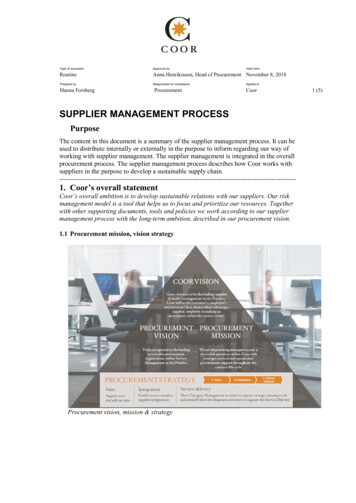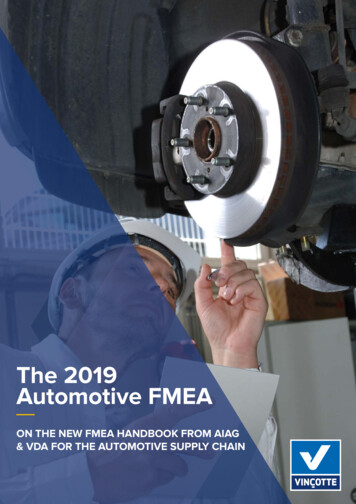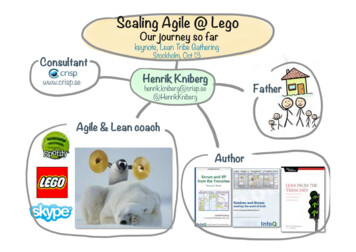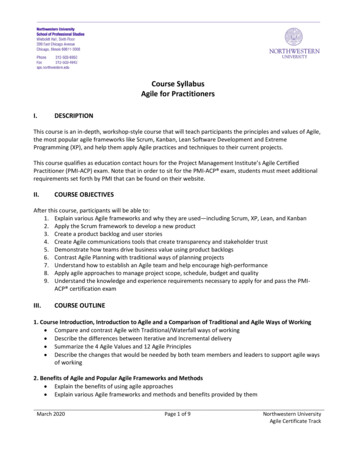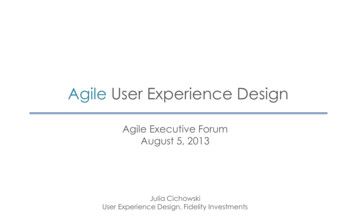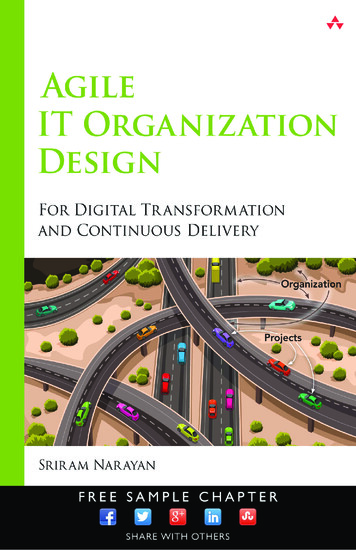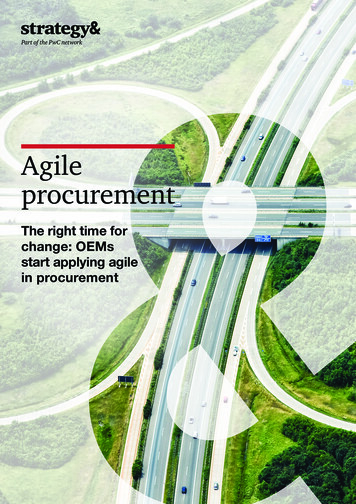
Transcription
AgileprocurementThe right time forchange: OEMsstart applying agilein procurement
ContactsLaura KronenDirector, PwC Strategy&Germany mAriane HohenseeManager, PwC Strategy&Germany comJörg AssmannPartner, PwC Strategy&Germany mKevin RotheManager, PwC Strategy&Germany obert WeissbarthDirector, PwC Strategy&Germany c.comHendrik FlockSenior Associate, PwCStrategy& Germany omNadine RaabeSenior Associate, PwCStrategy& Germany About the authorsLaura Kronen leads the European agile community ofStrategy&, the global strategy consulting team at PwC.She supports CxOs in building differentiating capabilitiesfor sustainable growth and digitization, based on her expertknowledge in agile ways of working, operational excellenceand Lean management. Laura is a Director of our Automotiveteam and based in Stuttgart. With 14 years of combinedconsulting and industry experience she combines the bestof both worlds.functional product cost management and design-to-valuealong the entire life cycle of products. He specializes inlarge-scale optimization programs including organizationalimprovement, process excellence, and building capabilitiesacross industries.Jörg Assmann is an advisor to executives in the automotiveindustry for Strategy&, the global strategy consulting teamat PwC. He is a Lead Partner at Strategy& Germany basedin our Frankfurt office and a member of the Strategy&Automotive Leadership Team. With his longstandingAutomotive experience in consulting and industry hisexpertise lies in restructuring and large-scale transformationprograms.Kevin Rothe is an advisor to clients in the automotiveindustry for PwC Strategy& Germany. He is a Managerin the Operations and Business Strategy Team and basedin Munich.Robert Weissbarth leads the strategic supply managementpractice in EMEA for Strategy&. the global strategy consultingteam at PwC. He is a director with Strategy& Germany.Based in Düsseldorf, he is a thought leader in all aspects ofprocurement and supplier management, as well as cross-Ariane Hohensee is a Manager at PwC Strategy& Germany,based in Berlin. She is an advisor in the transportation andautomotive industry with a special focus on Procurement.Hendrik Flock advises clients across industries in thearea of Procurement and Supply Chain Management forPwC Strategy& Germany. He is a Senior Associate in ourHamburg office and part of the Operations Strategy team.Nadine Raabe advices clients in the automotive industry.She is a Senior Associate for PwC Strategy& Germanyin the Corporate and Business Strategy team and basedin Munich.
EXECUTIVE SUMMARYCOVID-19 has impacted European automakers (OEMs) in three majorways: significant disruption in global supply chains; plant closures anda mass shift to remote working to protect the health of employees; anda drop in sales worldwide as a result of the economic shock.Even before this, OEM procurement teams were racing to keep up with the transition towardselectric, shared, connected and autonomous vehicles. Software is now one of the mostimportant components in new cars, and many procurement departments are experimentingwith agile ways of working to respond more effectively to the shorter and more flexibledevelopment cycles that software, and the integration with hardware, requires.Agile could become more widespread in procurement in the coming months, as COVID-19imposes rapid and wide-ranging organizational and behavioural change. With employeesworking from home wherever possible, rigid hierarchies and micro-managing projects areno longer practical or desirable. Agile practises such as using Kanban boards – workflowvisualization tools which can be shared remotely and used to present and track tasks in realtime – can facilitate effective remote working.We interviewed senior procurement executives at most of Europe’s largest carmakers tounderstand the current state of agile in their departments. This report examines the benefitsand the major obstacles to change, and provides recommendations how teams cansuccessfully integrate agile methods into the way they work.Strategy& Agile procurement1
Procurement on the front lineEven as software’s share of the overall value of cars is growing, the executives we interviewedagree that the core role of procurement departments remains unchanged: it is to strikecontracts with the best cost/value ratio with suppliers.With automated, connected and electrified features set to increase vehicle material costsby as much as 20 to 40 percent by 2030, according to Strategy&’s 2019 Digital Auto Report,the pressure for OEMs to drive down the cost of technology development is intense.Procurement departments are on the front line of this effort (see Exhibit 1).EXHIBIT 1Impact of regulation and innovation on vehicle bill of material 18% 42%1422-3Addition of advanced connectivity/head-unit-to-host connectedservices and enable (for example)vehicle usage for shared mobility12-22118 1 1Addition of advanced L4 ADASas enabler for autonomous drivingAddition of basic connectivityfor emergency response inaccordance with NCAPsafety requirements10049-5337Addition of basic L1-L2ADAS to accord withNCAP safety requirementsConnectivity and infotainment– High (add.)49-53Connectivity and infotainment– LowADAS – High (add.)ADAS – LowSwitch from ICE to BEVPowertrain – High (add.)636565Basic nonconnectedvehicle today2030Regulatory2030Fully-fledgedNote: Bill of material indexed to 100% in 2018Source: Strategy& analysis2Strategy& Agile procurementPowertrain – LowOthers
A large proportion of software development is expected to be outsourced or co-developedwith third-party tech companies. As a result, it will fall to procurement teams to identifythe right external partners and to manage contracts with them effectively. Not only willprocurement departments have a greater workload, they will also be working in new ways: The growing share of software makes developing new cars more complex and new typesof contract for work of this nature are needed As carmakers become service providers as well as manufacturers, for example by workingwith car-sharing services, procurement teams may be sourcing standalone software thatis entirely separate from vehicles Timeframes are shrinking: development cycles for technology elements are measuredin weeks and months and updates are ongoing - certain software will continue to beupdated remotely after the car has been soldProcurement teams must quickly become experts in evaluating proposals from softwaresuppliers for new products and features and managing costs once projects are underway.However these new evaluation models must not become roadblocks that slow downsoftware development.How agile can help and where procurement teamsare using itAgile began life in software development but is now starting to be used in a range of sectors,when companies need to solve problems brought about by increased volatility, uncertainty,complexity and ambiguity (see Exhibit 2, page 6).OEM procurement departments are starting to use agile for two reasons:12Enable procurement departments to work in partnership withtechnology suppliers and with internal process partners suchas engineering in an agile way.Agile has become the gold standard for solving complex problems,and will help teams to manage their significantly increasingworkload in a changing industry.All our interviewees have used agile in their departments, albeit on a small scale. Typically,they have applied an agile framework to individual small-scale projects, which we refer toas “lighthouses”, because they are set up to guide the way to more wide-scale adoption.They allow companies to gain experience in agile and learn first-hand what works andwhere obstacles lie.Procurement departments often started using agile in conjunction with research anddevelopment (R&D) departments and then set up their early “lighthouse” projects. Thesefocused on using disciplined agile meeting routines and tools to manage tasks, and createtransparency along defined sprints.Strategy& Agile procurement3
Rolling out agile more broadly is happening at varying speed: among the companies we spoketo, the leading adopters are those with the greatest focus on software. However they allrecognize agile is not a “one size fits all” solution and is not required for simple, repetitiveprocesses (see Exhibit 2, page 6).Based on their use of agile so far, the executives we spoke to identified thefollowing benefits:BettercollaborationCross-functional teams composed of members from all relevantdepartments and organizations following disciplined meetingroutines, and tracking progress using Kanban boards to visualizeworkflows has resulted in significantly improved communicationand cooperation within teams and across departments. Settingtargets for the team makes the group “mission focused,” ratherthan each person being driven by the targets and agenda of theirown parent department.Delegating decision-making powers increased employees’ motivationand sense of ownership, our interviewees found, and encouragedthem to learn new skills rather than simply following a to-do list.GreaterspeedOur interviewees reported that agile methods speed up projectssignificantly, at a time when development speed is becomingincreasingly important. During the request for proposal (RfP) phase,working in an agile way helps suppliers respond quickly to changingspecifications from the OEM, to deliver a proposal that is as close aspossible to what is required. The process of prioritizing tasks spedup considerably in teams using agile, and this in turn acceleratedtarget-setting across departments.Key performance indicators based on the time taken to completecycles of work are also becoming more common in procurementdepartments, increasing the pressure on teams to work faster.Moretransparency4Agile makes the goal of the project transparent to all team members,which OEMS and suppliers have found helps to set the right prioritiesand focus everyone’s efforts in the same direction. Sprint backlogsand other elements of agile such as disciplined meeting routines andreal-time visualization make current and future tasks clear. Thesemethods and tools can be used remotely while COVID-19 restrictionsremain in place.Strategy& Agile procurement
What are the challenges?While our interviewees recognize that, if properly introduced, agile ways of working can havesignificant benefits, they also identified the following challenges to putting agile in place:Expanding agileexpertiseWith the introduction of agile still in its early stages, procurementteams lack staff with experience using the framework. This is adifficult obstacle to tackle because agile experience is still mostcommon among software experts, given agile began in that industry,and OEMs have a hard time competing with technology giants torecruit people with a software background. Alternatively, upskillingand training of these methods are required.Updating waysof workingExisting performance evaluation processes and adequate pricingmodels for potential suppliers, for example, may not be relevant whenassessing services provided by a tech company working in an agileway. New tools and processes are needed to support the new ways ofsourcing and collaboration that procurement teams want to pursue.Cultural changeShorter product development life cycles require a whole new way ofthinking for both executives and employees. For management teams,this means increasing their acceptance of uncertainty in decisionmaking, for example by reviewing products at a much earlier stagein development, when they are still a work in progress and easierto change. Agile also requires a significant amount of decisionmaking power to move down the hierarchy. For this to work, bothmanagers and employees need to fully embrace the change to theway decisions are made and who needs to be consulted. Many ofour interviewees reported that this was one of the major obstaclesto achieve greater benefits from agile.Greater flexibilityin rolesIn agile teams, employees’ roles and scope may change from theiroriginal job description. Smart adaptations to HR processes and toagreements with employee representatives are needed to avoid aslow down or sometimes block of the creation of agile working teamsby preventing the necessary flexibility on tasks and responsibilities.Strategy& Agile procurement5
Agile in a nutshellAgile means working in dedicated, cross-functional, self-organizing teams to maximize customer value byquickly turning business requirements into working products. Teams build solutions incrementally, using theresults and feedback produced by each iteration to refine and improve the product. By working in this way,agile companies are able to respond quickly and flexibly to change, to master complexity and to manageprojects efficiently.Using agile successfully requires a cultural as well as an organizational change, and this can be the hardestthing for companies to do. Agile culture is based on trust, motivation and courage: for example being able tomake decisions without a perfect set of data. However it goes without saying that in the auto industry, whiledecisions can be taken in this way, safety is paramount and the end product must still reach 100 percent ofthe OEM’s quality targets.Agile ways of working are most effective when used to solve complex problems. For routine tasks, wellestablished ways of sourcing the right technology or product are often more suitable (see Exhibit 2).EXHIBIT 2Problem oticAOrder xBNovel practicesreact, sense, reactTask forceA?BAStrategy& Agile procurementBEmergent practicestest, sense, reactGood practicessense, analyze, reactAgileAgile – WaterfallSource: Based on the CYNEFIN Framework from Essential Scrum, Kenneth S. Rubin6SimpleARepetitiveBBest practicessense, categorize,reactLeanAAABBBStandard practicessense, categorize,reactAutomation
How to make the transition: roadmap, skills and toolsTo successfully implement agile processes, first and foremost employees and managers musthave the discipline to stick to the rules and approaches of the framework. The following threethings will help them to do so:1.Roadmap to agileA clear and transparent roadmap to ensure the entire procurement organization moves inthe same direction and that it can continue to act as an enabler for the wider organization.The change to agile methods takes time to get used to and to live up to its full potential,and teams need to understand the stages of the journey (see Exhibit 3).EXHIBIT 3Agile lighthouse based roll-out52461733 months“See one”EpicsActivities52 months“Do one”2 months“Lead one”812 months“Roll-out”Prepare thebasis for anagile implementation Understand need for agility Build common agileunderstanding Identify agile relevantprocesses Draft high level roll-out plan Define and implement KPIs tomeasure improvements Develop a communicationconcept to accompany agileimplementation Derive an agile implementationroadmap, includingpre-requisites Conduct agile procurementtraining Develop change concept forroll-out Understand need for agility Build common agileunderstanding Identify agile relevantprocesses Draft high level roll-out plan Develop agilecapabilities forsustainableresults Implement one agile lighthouse Showcase impact of agility Train future agile coaches andemployees on the job Implement two furtherlighthouses, supported byfuture agile coaches Training on the job Implement two furtherlighthouses, led by agilecoaches Training on the job Implement one agile lighthouse Showcase impact of agility Train future agile coaches andemployees on the jobSource: Strategy& analysisStrategy& Agile procurement7
An overarching agile transformation roadmap must also take into account that agile is notthe optimum framework for every type of procurement process as described above. Tasksmust be categorized to reflect this, and teams working in agile and traditional ways must stillbe able to work together effectively.2.Employee and leadersip skillsManagement support and additional coaching is required, especially at the beginning ofthe change and for new employees. Leaders must be able to clearly communicate the aimand expectations of the shift to agile ways of working, including the required discipline toadhere to meeting routines and the new roles and responsibilities of teams and leaders asdecision-making moves down the hierarchy.3.Tools enabling agileProcurement tools and methods need to be ready for agile ways of working: suitable awardand evaluation criteria for agile projects at the bidding stage (RfP); the way value contributionis measured must also be suitable for software-related products developed in an agile way.This may mean a shift from a one-sided view of savings for the OEM towards shared valuegeneration with the supplier.Procurement teams must also be able to agree on contracts that enable agile working withsuppliers, while at the same time ensuring an adequate pricing model that gives the internalcustomer transparency and control over the cost of the development effort, for examplecontracts which allow third-party suppliers to be more closely involved with internaldevelopment processes.8Strategy& Agile procurement
The road aheadWe expect agile to become increasingly important to procurement teams at carmakers.It might help them to recover more quickly from the economic shock and supply chaindisruption of COVID-19, in addition to keeping pace with the transformation of the industry.As more and more parts of a car are controlled by digital technology, procurement teamswill need different skill sets to evaluate and cooperate with software partners. Howevercultural change and leadership are just as important: during the ramp-up phase in particular,teams may find their workloads increase. They may struggle with new ways of working.Our interviewees all agreed management support for the change is crucial at this time,and vital to allow all the long-term benefits to bear fruit.Strategy& Agile procurement9
Strategy&Strategy& is a global strategy consulting business uniquely positioned to help deliver yourbest future: one that is built on differentiation from the inside out and tailored exactly to you.As part of PwC, every day we’re building the winning systems that are at the heart of growth.We combine our powerful foresight with this tangible know-how, technology, and scale tohelp you create a better, more transformative strategy from day one.As the only at-scale strategy business that’s part of a global professional services network,we embed our strategy capabilities with frontline teams across PwC to show you where youneed to go, the choices you’ll need to make to get there, and how to get it right.The result is an authentic strategy process powerful enough to capture possibility, whilepragmatic enough to ensure effective delivery. It’s the strategy that gets an organizationthrough the changes of today and drives results that redefine tomorrow. It’s the strategythat turns vision into reality. It’s strategy, made real.www.strategyand.pwc.com 2020 PwC. All rights reserved. PwC refers to the PwC network and/or one or more of its member firms, each of which is a separate legal entity.Please see www.pwc.com/structure for further details. Mentions of Strategy& refer to the global team of practical strategists that is integratedwithin the PwC network of firms. For more about Strategy&, see www.strategyand.pwc.com. No reproduction is permitted in whole or part withoutwritten permission of PwC. Disclaimer: This content is for general purposes only, and should not be used as a substitute for consultation withprofessional advisors.
With the introduction of agile still in its early stages, procurement teams lack staff with experience using the framework. This is a difficult obstacle to tackle because agile experience is still most common among software experts, given agile began in that industry, and


